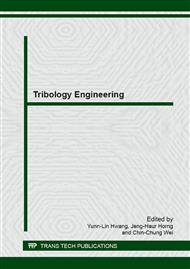[1]
A.A. Edigaryan, V.A. Safonov, E.N. Lubnin, L.N. Vykhodtseva, G.E. Chusova and Y.M. Polukarov: Properties and preparation of amorphous chromium carbide electroplates, Electrochimical Acta, Vol. 47(2002), pp.2775-2786.
DOI: 10.1016/s0013-4686(02)00163-9
Google Scholar
[2]
Commission of the European Communities. Raw Materials(Materials Substitution Dossiers) Part 1, Silver and Chromium [M]. Brussels, (1980).
Google Scholar
[3]
M. El. Sharif and C.V. Chisholim: Electrodeposition of thick chromium coat-ings from an environmentally acceptable chromium (Ⅲ) glycine complex, Tran, IMF, Vol. 77(1999), pp.139-144.
DOI: 10.1080/00202967.1999.11871269
Google Scholar
[4]
S.M. El: Electrodeposition Acceptable Process from Electrodeposition of Hard Chromium (Ⅲ) Electrolyte, Trans. IMF., Vol. 77 (1999), pp.139-144.
Google Scholar
[5]
S.M. El: Replacing Hexavalent Chromium in Electroplating , Trans. IMF., Vol. 75(1997), pp.143-146.
Google Scholar
[6]
V.M. Knyazheva, S.G. Babich, V.I. Kolotyrkin, and V.B. Kozhevnikov: Electrochemical-Corrosion Properties and Electronic Structure of Chromium Carbides, Nitride, and Carbonitride, Protection of Metals (English translation of Zaschita Metallov), Vol. 26(1991).
DOI: 10.4028/www.scientific.net/kem.20-28.473
Google Scholar
[7]
S.C. Kwon and M. Kim: Characterization of intermediate Cr-C layer fabricated by electrodeposition in hexavalent and trivalent chromium baths, Surface Coating & Technology, Vol. 158(2004), pp.151-156.
DOI: 10.1016/j.surfcoat.2003.09.069
Google Scholar
[8]
Z. Zeng, L. Wang, A. Liang and J. Zhan: Tribological and electrochemical behavior of thick Cr–C alloy coatings electrodeposited in trivalent chromium bath as an alternative to conventional Cr coatings, Electrochimica Acta, Vol. 52(2006).
DOI: 10.1016/j.electacta.2006.07.038
Google Scholar
[9]
Z. Zeng, L. Wang, A. Liang, L. Chen and J. Zhang: Fabrication of a nanocrystalline Cr–C layer with excellent anti-wear performance, Materials Letters, Vol. 61(2007), pp.4107-4109.
DOI: 10.1016/j.matlet.2007.01.066
Google Scholar
[10]
C. A. Huang , U. W. Lieu and C. Chuang: Huo Role of nickel undercoat and reduction-flame heating on the mechanical properties of Cr–C deposit electroplated from a trivalent chromium based bath, Surface & Coatings Technology, Vol. 203(2009).
DOI: 10.1016/j.surfcoat.2009.03.010
Google Scholar
[11]
S. Ghaziof, K. Raeissi and M.A. Golozar: Improving the corrosion performance of Cr–C amorphous coatings on steel substrate by modifying the steel surface preparation, Surface & Coatings Technology, Vol. 205(2010), pp.2174-2183.
DOI: 10.1016/j.surfcoat.2010.08.123
Google Scholar
[12]
S. Ghaziof, M.A. Golozar and K. Raeissi: Characterization of as-deposited and annealed Cr–C alloy coatings produced from a trivalent chromium bath, Journal of Alloys and Compounds, Vol. 496(2010), p.164–168.
DOI: 10.1016/j.jallcom.2010.02.101
Google Scholar
[13]
C.E. Lu, N.W. Pu, K.H. Hou, C.C. Tseng and M.D. Ger: The effect of formic acid concentration on the conductivity and corrosion resistance of chromium carbide coatings electroplated with trivalent chromium, Applied Surface Science, Vol. 282(2013).
DOI: 10.1016/j.apsusc.2013.06.008
Google Scholar
[14]
V.S. Protsenko, F.I. Danilov, V.O. Gordiienko, A.S. Baskevich and V.V. Artemchuk: Improving hardness and tribological characteristics of nanocrystalline Cr–C films obtained from Cr(III) plating bath using pulsed electrodeposition , International Journal of Refractory Metals and Hard Materials, Vol. 31(2012).
DOI: 10.1016/j.ijrmhm.2011.10.006
Google Scholar


